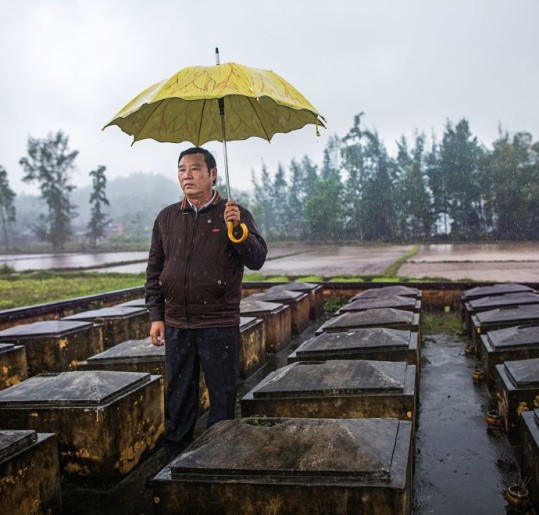Tags
"Return to Mylai", Katie Orlinsky, Mylai massacre, Symour M. Hersch, The New Yorker, Vietnam War

Pham Thanh Cong, the director of the My Lai Museum, was eleven at the time of the massacre. His mother and four siblings died. “We forgive, but we do not forget,” he said. Credit Photograph by Katie Orlinsky – The New Yorker
Having recently returned from a trip to Vietnam and Cambodia and being continually disturbed, and sometimes mystified, about the US role and legacy in that part of the world, I was attracted to the current issue of the New Yorker and Seymour M. Hersh’s article Return to My Lai: The Scene of the Crime – A reporter’s journey to My Lai and the secrets of the past.
Hersh, as you may remember, particularly if you ‘came of age’ during the Vietnam War, broke the story about the My Lai massacre, which, in part, led to a reexamination of our role in that war and in that part of the world.
Now, 47 years later, Hersh returns to Vietnam and specifically to My Lai and discovers things he did not know when he uncovered and wrote about the My Lai massacre.
Check out: Return to My Lai
Also, in a companion ‘article’, there are photographs by New Yorker photojournalist Katie Orlinsky, who accompanied Hersh on this trip. Check out: The Memory of My Lai.


Micah Sifry said:
This essay completely stopped me in my tracks today.
I am glad Seymour Hersh is still capable of this kind of reporting. And let him keep pursuing Robert McNamara’s ghost; may that evil man rot in hell.
Carrie said:
Science has shown that we are all capable of doing horrendous things if we believe it is for an acceptabile reason. So it seems to me we all need to be very careful to exam what our leaders, news outlets and even friends tell us.
Land said:
The massacre at My Lai was a copy of the massacre, by American troops, of Japanese soldiers in WW II (the U.S. Army took very few prisoners. The Marine Corps took almost none) and German troops during the Battle of the Bulge (My uncle told me stories until he was crying so hard he could not continue).
Killing civilians has a long widely followed tradition stretching back into the early books of the Old Testament and the practice is certainly older still. It was expected during the Middle Ages. It occurred by both sides during the American Revolution. During the Civil War, it was done more “humanely” by putting prisoners in concentration camps where the lack of food, decent water, or medical care was guaranteed to kill all but a few. Many American Indian villages were obliterated as they were ejected from New England, Florida, Georgia, Kentucky, Tennessee, the Dakotas, Texas, New Mexico, Arizona, in the 1880-1890s, General Sherman was being optimistic when he proclaimed; “War is Hell”. He should have said “Hell is simply Hell. War is worse”
I have no illusions about the force used by the United States to create or maintain the existence of this country, and reluctantly acknowledge that without it, we would be a series of colonies of other powers. Rome and every other empire in history was brutal and that is the price that is demanded of those who would wield high power.
Humans have always waged unceasing annilation against any creature we deem to be dangerous, nay, even those deemed to be threatening (lions, wolves, tigers, orcas, mammoths, sabre toothed cat, neanderthal, homo erectus, passenger pigeon, dodo bird, mountain gorillas, black and white rhinos, supporters of other city’s sports teams),
We also arm police and give them the power and authority to kill but we don’t ask children (under 23) to do that job because we know that they are immature and cannot be trusted to not pull the trigger when startled or frightened.
Only children think that war is glorious or that they are immortal and cannot be injuried or killed or that all orders given by their superiors must be obeyed. Unfortuately it is in the human DNA and will be the reason why humans will not be welcome when we start to spread through the galaxy and begin trying to exterminate hostile life on planets we find to be inhabitable. It may be that the fate of Alderaan will be Earth’s fate.
Land